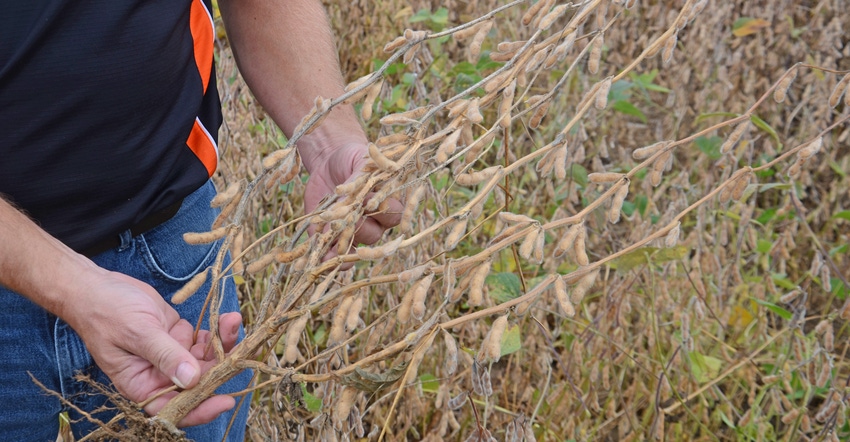
Sometimes things happen and you don’t get the soybean stand you expect or desire in every row across the field. In no-till fields, perhaps the planter row lines up over an old cornstalk row for a stretch, and some soybeans don’t get placed correctly. In conventional soybeans, maybe a hard rain crusts the soil, and some soybeans don’t emerge. Or maybe slugs or seedcorn maggots thin stands early in the season.
Steve Gauck, a regional manager for Beck’s, based near Greensburg, Ind., doesn’t worry as long as there are 80,000 healthy plants per acre and weeds are under control. Visiting soybean fields in late September, including the Soybean Watch ’21 field, he found multiple examples of plants that explain why he doesn’t worry about populations of 80,000, or perhaps even slightly less. Beck’s sponsors Soybean Watch ’21.
Related: Late dry spell hit some soybean fields hard
“Soybeans have a tremendous ability to compensate, especially compared to corn,” Gauck says. “One way they compensate is by sending out branches if they don’t sense another plant nearby early in the season.
“Those branches are important because one way you add yield is having more total nodes and total pods per acre. When a soybean branches, that plant may have 40% or 50% more pods compared to a plant without branches where the stand was thicker, which may have considerably fewer pods, depending upon the population.”
Making up yield
Those extra pods mean one plant can quickly make up for a missing plant, perhaps more than one. It depends upon the number of branches the plant produces, and how many pods wind up on a single plant.
Gauck believes modern varieties tend to branch more, if given the opportunity, than some varieties of the past. It’s one reason why thinner stands don’t bother him as they might have concerned an agronomist 20 or 30 years ago.
“You have the situation where the entire stand is on the thin side, and many plants are encouraged to produce one or more branches,” he explains. “You also have the case where perhaps every other row or every so many rows in a field of beans no-tilled into cornstalks wound up over the old corn row. In one field this year, the rows over the corn row were thinner, and it was obvious to pick up early in the season.
But by just before harvest, the beans in the thinner row had branched enough that if you didn’t already know it, you would have difficulty picking out the rows that were thinner at a distance.”
One way to avoid the problem of a new bean row lining up over an old cornstalk row across the field, affecting planter performance, is to plant at a slight angle, he says. Bean rows will cross old stalk rows, but they won’t be on them for a long distance, producing long stretches where stands might be thinner.
You may also want to check disk openers on the planter for wear, to make sure they can cut through residue properly, he notes. Yet another option is installing a different type of stalk roll on the corn head or using some sort of attachment to better distribute residue and reduce the impact of stalk stubs.
About the Author(s)
You May Also Like




